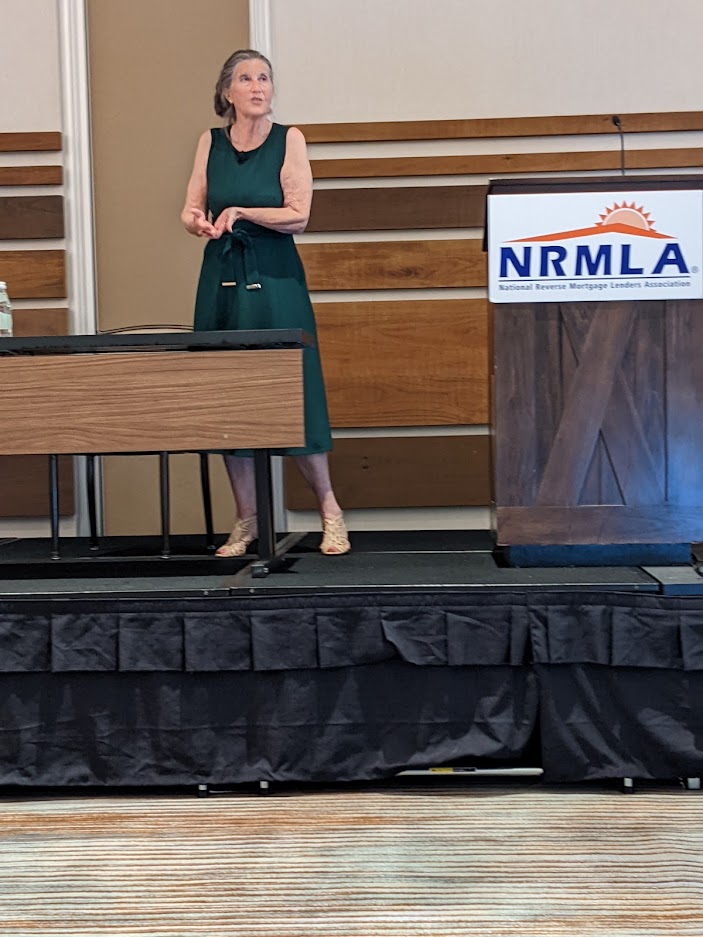Keeping the unique difficulties of older Americans in mind is essential to becoming a recognized resource in any industry that caters to them, especially a business like the reverse mortgage industry. On top of that, finding ways to become a subject matter expert in terms of information absorbed by professionals and contacts maintained in adjacent industries and advocacy groups can be essential building blocks for success.
This was a perspective shared by Fritzi Gross-Daillon, director of education and advocacy at Age Safe America, an organization aiming to connect seniors with dedicated advocates in necessary industries that serve seniors’ unique needs in realms such as home modification, financial advisors, ADU coalitions and senior interest groups.
Speaking recently at the National Reverse Mortgage Lenders Association (NRMLA) Western Regional Meeting in Irvine, Calif., Gross-Daillon described to an assembled audience of reverse mortgage professionals the necessity that expertise may bring to their businesses in addition to providing more necessary resources for the seniors served by the reverse mortgage business.
Facts about older Americans and reverse mortgage customers
Gross-Daillon’s presentation was titled “networking means never having to say you’re sorry,” a twist on a famous line from the 1970 Erich Segal novel Love Story and brought into popular consciousness by the film adaptation released that same year. The actual line, “love means never having to say you’re sorry,” was uttered by actress Ali McGraw and popularized from there.
“It turns out that 50 years ago when Ali McGraw was saying that, now she fesses up that she hated that line in the movie,” Gross-Daillon said. “But for us, networking really can mean that we are not saying we are sorry to our clients or our colleagues, because we may not have the information they need.”

According to data shared during the presentation, 85% of people in the baby boomer demographic — those born between 1946 and 1964 — want to remain in their own homes, but 90% have done little or nothing to prepare for that. In response to other conversations Gross-Daillon listened to at the conference, she described hearing how some of the assembled professionals discussed the possibility of their clients returning to work in a post-COVID world, which could mean that many seniors will work from home.
“We’ve got some more facts about folks at home,” she says. “One in three over [the age of] 65 will fall, and one in two over 80 will fall, which happens to be the leading cause of death among older adults.”
Because people tend to compensate in older age after experiencing a fall, older people could become more cautious when walking and that could have a side effect of reducing their mobility even further over time in order to try and avoid a repeat fall. Additionally while more people stayed at home during the pandemic, Gross-Daillon cites statistics that flew in the face of conventional wisdom that said more people at home might mean that they also would find time to get out of the house and walk around more.
“Turns out, it wasn’t true,” she said. “People weren’t walking or exercising as much. We lost our flexibility, mobility and muscle mass and people fell at greater rates. At least 40% of them did not seek or receive medical attention that they thought they should have, all related to the COVID environment. So, in addition to the other social factors that we’ve been talking about today in terms of isolation and ways to support our senior populations, all of these elements are coming into play.”
The evolution of aging in place, how reverse mortgages factor in
The concept of aging in place in one’s own home has become mainstream, she explained. It is appearing more regularly in media, but it’s also opening up the possibility for new businesses to be created that can help facilitate that shift. For years, many people had assumed that assisted living of some kind was a foregone conclusion, but people are beginning to rethink that dynamic more broadly.
“If mom was there in the last couple years, spending $5,000-$7,000 a month to have dinner in the room on a cardboard tray by herself with plastic utensils is now causing folks to rethink what [that arrangement],” she says. “Our opportunity is to look at changing our homes for the multigenerational component, and this is where a lot of the creativity that you all bring to the clients and to the marketplace is going to help support these changes.”
Because aging in place is so central to the narrative which often surrounds the discussion of reverse mortgages, professionals who operate in the space may be uniquely suited to help facilitate these new chances for better preparing seniors to age in place, she explains. Since seniors often maintain contact with their loan originators, they can often become an authority on aging in place matters in the eyes of clients and their families.
“You’re the point of connection, and so families and seniors will come back to you because of this intimate role that you have played with them in their lives to be able to create this new independence,” she says. “[We also need to ask], what are the client’s needs and wants as it relates to our ability to provide those resources to them?”
To facilitate aging in place after a loan closes, natural questions from a client or their family might arise regarding how the loan proceeds can then be applied to retrofit a home or to find socialization services for seniors, she explains.
“Once we’ve successfully conducted the reverse mortgage transaction, they then have opportunities with their funding to be able to do a variety of things,” she says. “And there may be questions about finding those services that support the additional needs [that could come with aging in place]. Things like ongoing home care, other transportation options, socialization options, smart home technology, etc.”



